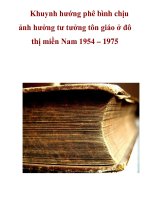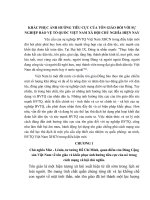British study london and religion Tôn giáo Anh
Bạn đang xem bản rút gọn của tài liệu. Xem và tải ngay bản đầy đủ của tài liệu tại đây (4.54 MB, 51 trang )
TOP TEN attractions of London
Big ben
Tower Bridge
London Eye
H
o
u
s
e
s
o
f
P
a
r
l
i
a
m
e
n
t
Piccadilly Circus
T
o
w
e
r
o
f
L
o
n
d
o
n
T
r
a
f
a
l
g
a
r
S
q
u
a
r
e
S
t
.
P
a
u
l
'
s
C
a
t
h
e
d
r
a
l
W
e
s
t
m
i
n
s
t
e
r
A
b
b
e
y
B
u
c
k
i
n
g
h
a
m
P
a
l
a
c
e
Big Ben
Saint Stephen's Tower
What is Big Ben?
•
Big Ben is one of the most famous
landmarks in the world. It is the
clock tower. The name Big Ben is
used to describe the clock tower
that is part of the Palace of
Westminster.
•
Big Ben is situated on the banks of
the River Thames on the north side
of the Houses of Parliament in
Westminster, London.
•
Even after the nearby House of Commons was
destroyed by bombing during World War II, the
clock kept on chiming. The clock's mechanism,
designed by Edmund Beckett Denison, has a
remarkable accuracy.
•
At the base of each clock face is a Latin
inscription, in gilt letters. It reads
“Domine salvam fac Reginam nostrum Victoriam
Primam”
"O Lord, keep safe our Queen Victoria the First"
How heavy is Big Ben bell?
•
The Big Ben bell has the following
measurements: 9'-0" diameter, 7'-6" high, and
weighs 13 tons 10 cwts 3 qtrs 15lbs (13,760
Kg)
When can we hear the bell ring?
•
Big Ben chimes every 15 minutes and the
sound can be heard for a radius of up to 5
miles.
Tower Bridge
•
Where does the Tower Bridge stand ?
Tower Bridge has stood over
the River Thames in London since 1894 and
is one of the finest, most recognisable
bridges in the World.
•
Why is the Tower Bridge special?
Tower Bridge is the only Thames bridge
which can be raised.
The middle section can be raised to
permit large vessels to pass the
Tower Bridge. Engines raise the
bridge sections, which weigh about
1000 tons each, in just over a
minute. It used to be raised about 50
times a day, but nowadays it is only
raised 4 to 5 times a week.
Bridge History
Plans for the Tower Bridge were
devised around 1876 when the
east of London became
extremely crowded and a bridge
across the Thames in that area of
the city seemed necessary.
Five contractors and nearly 450
workers were involved in the
construction of the 265 meter
long bridge. It took 11,000 tons
of steel to build the framework.
London Eye
Millennium wheel
A modern but already very popular tourist attraction, a giant observation wheel located in the
Jubilee Gardens on the South Bank, between Westminster and Hungerford Bridges.
The wheel was constructed in sections which were
floated up the river Thames on barges and assembled
lying flat on pontoons.
Quick facts about London Eye:
•
The total weight of steel in the Eye is 1,700 tonnes.
•
The London Eye can carry 800 passengers at a time on
a thirty-minute ride. From its highest point of 450 feet,
it promises views of up to 25 miles.
•
The London Eye stands 135 metres (443 feet) high.
The observation wheel turns slow
enough for people to embark
while it is moving. A complete turn
takes about thirty minutes.
Thanks to the construction of the
glass capsules on the outer side of
the rim, the passengers have a
great 360 degree view over
London.
(The London Eye as seen from Westminster Bridge
with the London Aquarium and County Hall to the right)
capsules
Houses of Parliament
Palace of Westminster
The Houses of Parliament, also known as the Palace of
Westminster, is the seat of the two parliamentary
houses of the United Kingdom: the House of Lords and
the House of Commons.
From the middle of the 11th century until 1512 the Palace of Westminster was the royal
home to the Kings and Queens of England.
(View from the London Eye )
The Palace of Westminster features THREE main
towers
•
Big Ben
The most famous part of Charles Barry's design is the
elegant clock tower. A light at the top of the tower is
illuminated when Parliament is sitting at night.
•
Victoria Tower
-
Opposite the Big Ben ,built in 1860.
-
The tower contains the records of both
the House of Lords and the House of Commons since
1497.
- During the parliamentary year the Union Flag is
hoisted on top of the 98 meter-tall tower.
•
Westminster Hall
-The oldest hall of the Houses of Parliament , dating back
to 1097.
-The large hammer beam roof was built in the fourteenth
century and replaced the original roof which was supported
by two rows of pillars.
-The hall is one of Europe's largest unsupported medieval halls.
Piccadilly Circus
Facts:
•
A busy square in the heart of London.
•
It is famous for the fountain installed here at
the end of the nineteenth century and for the
neon advertising that turned the square into
a miniature version of Times Square.
•
The Circus lies at the intersection of five main
roads: Regent Street, Shaftesbury Avenue,
Piccadilly Street, Covent Street and
Haymarket.
•
There is seminude
statue on top of the
fountain depicts
named Eros ,god of
love and beauty.
•
The statue is made
of aluminum.
•
London's first
illuminated
billboards were
installed here in
1895.
(billboards at the Circus)
The creation of
Shaftesbury Avenue in
1885 turned the plaza
into a busy traffic
junction. This made
Piccadilly Circus attractive
for advertisers.
(The Circus at night)
Tower of London
What is the Tower of London?
For over 900 years, the Tower of London has been standing guard over the capital. The
Tower of London was originally built by William the Conqueror, following his successful
invasion of England in 1066.
London has played different roles in British History: a Royal Palace, fortress, prison,
place of execution, arsenal, Royal Mint, Royal Zoo and Jewel house.
Today the Tower of London is best known for its Crown Jewels (the collection of
Crown Jewels that has been on display here since the seventeenth century, during the reign of
Charles II, now is museum), but it used to be notorious for the many political opponents of
the kings that were locked, tortured and killed in the Tower. The Tower was also a royal
residence.
In the centre of the Tower of London is the famous White Tower.
It is the tallest building in London at 27.4 meters (90ft). Its walls are 4.6 meter wide.
The building has four domed turrets at each corner. Three of them have a square shape, the
other is round, due to its spiral staircase. The round turret was long used as an observatory.
Other Towers
•
When two defensive walls were built around the White Tower. The inner
wall had thirteen towers and the outer wall had another six. The towers
were mostly used to imprison political opponents.
•
Some of the most famous prisoners locked in the Tower were two princes,
the sons of king Edward IV. The princes were never seen again and were
probably killed by guards.
The St. Thomas Tower is located close to the Bloody Tower. Here, prisoners were brought into
the fortress by boat through the Traitor's gate.
(Bloody Tower)
(St Thomas Tower)
Beauchamp Tower
(Important prisoners were locked in here)
Tower Green
Thomas More and Queen Elisabeth I was confined here
The main entrance of the Tower of London
Byward Tower
Bell Tower
Yeoman Warders (Beefeaters)
Dressed in historic clothes, they not only guard the tower, but also give guided tours of the fortress. One
of the about forty Yeoman Warders is known as the Ravenmaster, responsible for the ravens that have
been living here for centuries.
Legend has it that the Tower and the kingdom will fall if the ravens leave. Hence King Charles II placed the
birds under royal protection and the wings of the ravens are clipped to prevent them from flying away.
Buckingham Palace
•
Buckingham Palace was originally a grand house built by the Dukes of Buckingham for his wife. George IV began transforming
it into a palace in 1826.
•
It is the Queen's official and main royal London home. It has been the official London residence of Britain's monarchy since
1837. Queen Victoria was the first monarch to live there.
•
It is used also for the administrative work for the monarchy.
•
The Palace has around 600 rooms, including 19 State rooms, 52 royal and guest bedrooms, 78 bathrooms, 92 offices, a
cinema and a swimming pool. It also has its own post office and police station.
•
About 400 people work at the Palace, including domestic servants, chefs, footmen, cleaners, plumbers, gardeners, chauffeurs,
electricians, and two people who look after the 300 clocks.
(One of the two traffic gates)
Who guards the palace? What do they wear?
Five regiments of Foot Guards guard the Palace. They wear red jackets and tall, furry hats
called bearskins.
A familiar sight at Buckingham Palace is the Changing of the Guard ceremony that takes
place at 11 o’clock in the forecourt each morning.
Queen Victoria Memorial
Right in front of the
building is the Queen
Victoria Memorial,
designed by Sir Aston
Webb and built in
1911 in honor of
Queen Victoria, who
reigned for almost
sixty-four
years.
Trafalgar Square









